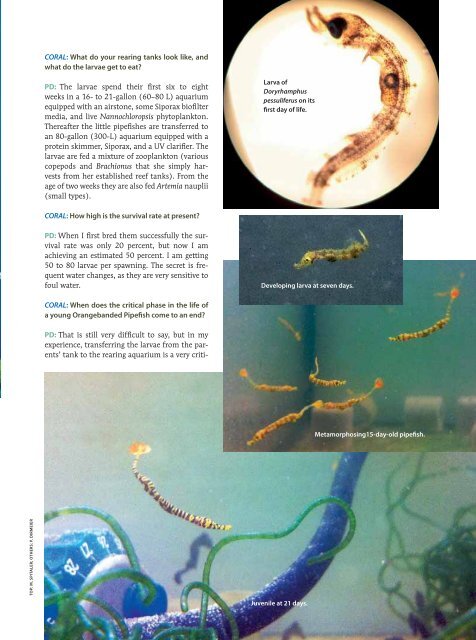Create successful ePaper yourself
Turn your PDF publications into a flip-book with our unique Google optimized e-Paper software.
CORAL: What do your rearing tanks look like, and<br />
what do the larvae get to eat?<br />
PD: The larvae spend their first six to eight<br />
weeks in a 16- to 21-gallon (60–80 L) aquarium<br />
equipped with an airstone, some Siporax biofilter<br />
media, and live Nannochloropsis phytoplankton.<br />
Thereafter the little pipefishes are transferred to<br />
an 80-gallon (300-L) aquarium equipped with a<br />
protein skimmer, Siporax, and a UV clarifier. The<br />
larvae are fed a mixture of zooplankton (various<br />
copepods and Brachionus that she simply harvests<br />
from her established reef tanks). From the<br />
age of two weeks they are also fed Artemia nauplii<br />
(small types).<br />
Larva of<br />
Doryrhamphus<br />
pessuliferus on its<br />
first day of life.<br />
CORAL: How high is the survival rate at present?<br />
PD: When I first bred them successfully the survival<br />
rate was only 20 percent, but now I am<br />
achieving an estimated 50 percent. I am getting<br />
50 to 80 larvae per spawning. The secret is frequent<br />
water changes, as they are very sensitive to<br />
foul water.<br />
Developing larva at seven days.<br />
CORAL: When does the critical phase in the life of<br />
a young Orangebanded Pipefish come to an end?<br />
PD: That is still very difficult to say, but in my<br />
experience, transferring the larvae from the parents’<br />
tank to the rearing aquarium is a very criti-<br />
Metamorphosing15-day-old pipefish.<br />
TOP: M. SPITALER; OTHERS: P. DIRMEIER<br />
Juvenile at 21 days.<br />
CORAL 101

















